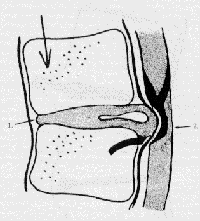Once a disc has herniated there is no way of 'putting it back.' Anyone who claims to replace a 'slipped disc' is, without doubt, not being accurate. It is possible, with manipulation, to ease the pressure on the disc, then with gentle exercise and care the slow repair can take place. In rare cases surgery may be needed to remove the extruded pulp, but I would suggest that surgery should never be resorted to before an osteopath has been consulted.
| Cross Section Showing: 1. Prolapsed Disc |  | 2. Pressure on Nerve Root. Such a condition would produce sciatic pain if this occurred in the Lumbar Spine. |
Whether short-term painful joint problems, or long-term general health conditions are the reason for consulting an osteopath, the way the individual uses his body will to a large extent determine whether or not recurrence of the problem takes place. For this reason it is vital that after correction of areas of dysfunction, the patient be instructed in the correct use of the body and in appropriate exercises. Many osteopaths also advise their patients on correct nutrition and in this way provide a comprehensive health care service.
 | Cross Section of Spine showing: 1. Prolapsed Disc; 2. Bone Degeneration. |
Other Complaints Which Osteopathy May Help
Without attempting to cover all the possible disease states that osteopathic manipulative therapy might be able to help. I list below a selection of examples with the idea of giving some idea of osteopathy's possibilities.
Allergic Conditions
The treatment of causes rather than symptoms is of first importance, and a lot of attention will need to be given to both the nutritional and stress related aspects of the problem. There are, though, quite often cases where osteopathic manipulation can help. In asthma, for example, areas of dysfunction may be found around the second thoracic vertebra, and there are always restrictions in the normal range of movement of the ribs. Such structural problems may be improved or corrected by osteopathic treatment, but if nothing is done about the underlying hormonal, nutritional and stress factors there is a strong likelihood that the allergy will reappear.
In most cases of allergy there is a degree of adrenal gland dysfunction (inadequate adrenaline production in response to repeated stress arousal, for example) or liver dysfunction (inadequate production of anti-hystamine in response to allergic hystamine production). Both these organs can be to some extent adversely affected over a period of time by mechanical disorders in the spine, and spinal correction through osteopathic manipulation can sometimes bring about an improvement of function.
Arthritis
The localized degenerative changes to joints which are collectively labelled osteo-arthritis or osteo-arthrosis is afflicting the majority of people over 35 who live in industrialized countries, and the term 'wear and tear' adequately describes the joint damage which results from the misuse of the postural and weight-bearing joints such as the spine, hips, knees etc.
In the early stages of such wear and tear, when disability is first becoming apparent in the form of stiffness, discomfort and slight limitation of movement, it is possible through osteopathic manipulative treatment to halt, and perhaps even reverse, the initial damage to the soft tissues which precedes the actual joint surface damage.